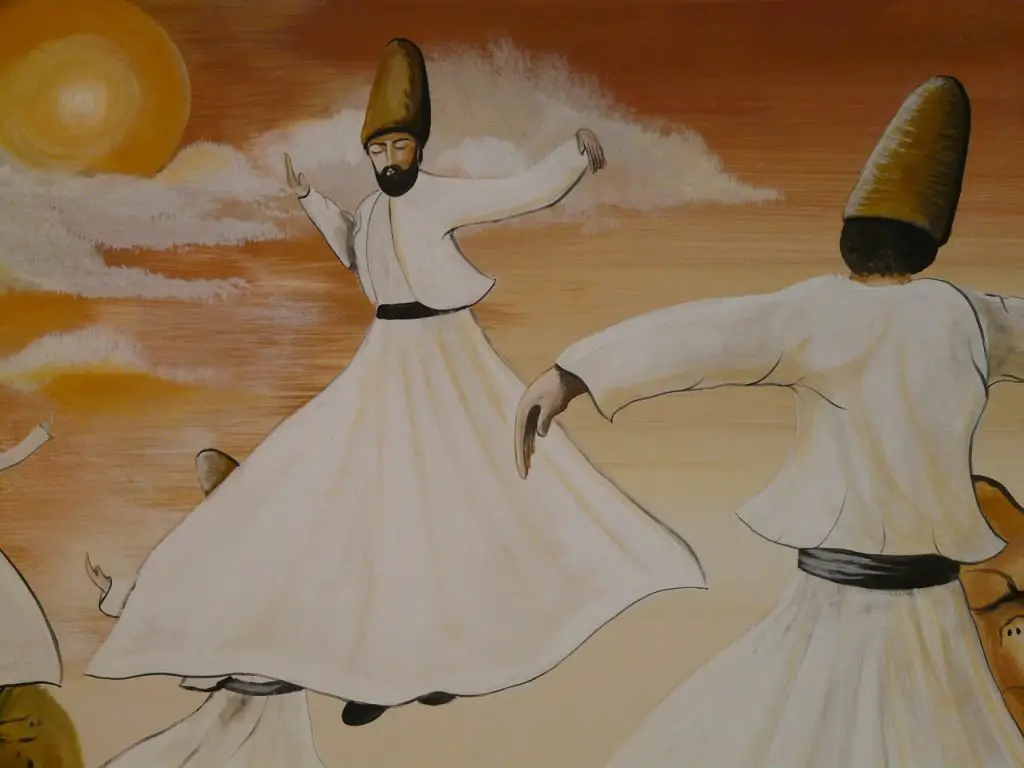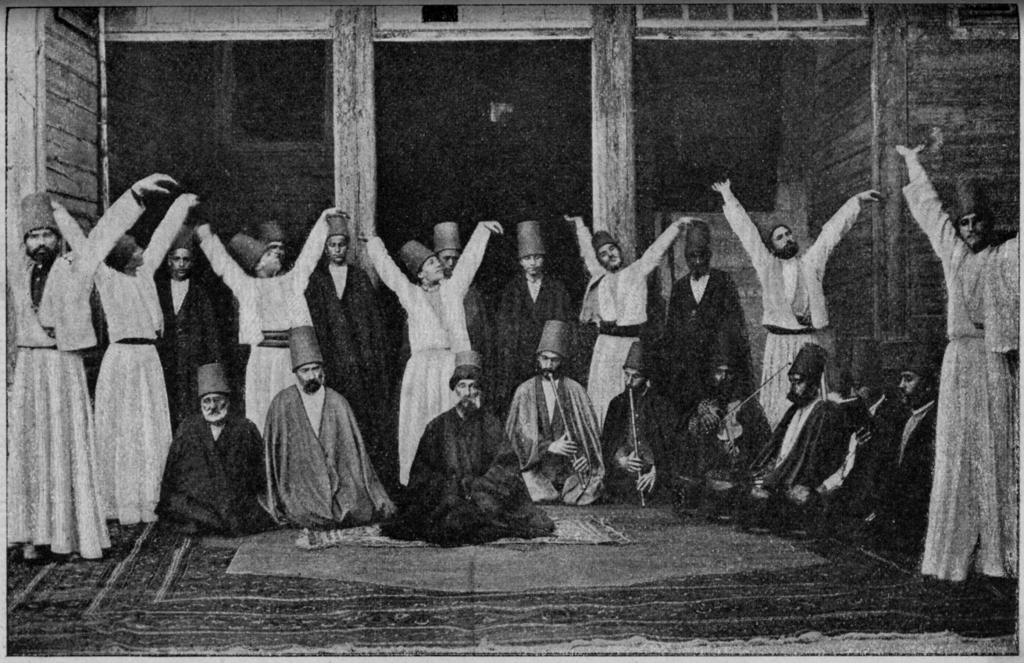
The one image that exceedingly alludes to Turkey’s rich cultural heritage is that of a group of men, clad in white flowing robes taking a series of mesmerizing turns with their arms spread out. These Whirling Dervishes are truly the crown jewel of the Turkish culture. A true amalgamation of art and spirituality, this tradition is a visual treat, along with being the perfect opportunity to suspend a restless mind. It effortlessly incorporates the fundamental Sufi principle of embracing divine presence in life. The ceremony itself is extremely symbolic, with each action highlighting a Sufi concept. To truly appreciate all the intricate details of the ceremony, here’s a brief history of the Whirling Dervish, Turkey.
Whirling Dervish Ceremony
The Whirling Dervish ceremony was originally a form of meditation in Sufism – the mystical order of Islam that is often described as the ‘inward dimension of Islam’. Born in 1207 in present-day Afghanistan, the Mevlana Jalal ad-Din Muhammad Rumi, more commonly known by his last name, is the man behind this interesting tradition. He eventually settled in Konya, situated in what is today, Turkey. His teachings laid the foundation for the Mevlevi order of Sufism formed in 1312 by his followers. The Mevlevi order seeks to know Allah not just through books but through direct personal experience. Sultan Walad, Rumi’s son, organized the Mevlevi order in Konya. At its peak, the appointed leaders who were staunch believers of Sufism and followers of Rumi expanded the Mevlevi Order with as many as 114 tekke (monasteries) throughout the Ottoman Empire, including some in Athens, Baghdad, Belgrade, Cairo, Damascus, Mecca, and Tabriz.
After World War 1, the fall of the Ottoman Empire caused the tekkes to either close or transform into mosques and museums. The Mevlevihane in Konya (Rumi’s burial place) and Galata Mevlevihanesi in Istanbul are two of the most important remaining ones. In 1925, Turkey’s first President, Mustafa Kemal Ataturk, closed all the orders in his bid to secularize the nation. The practice of Sema, or the Whirling Dervish’s prayer ceremony, was relegated to the underground. In 1956, though the law still upheld its decision of outlawing the Sufi sects, the public performances of the Whirling Dervish were revived as a cultural asset.
The Whirling Dervishes strove to keep this rich tradition alive by spreading it outside Turkey. They began by gracing the death anniversary of Rumi with performance, and this tradition became an annual nine-day December festival in Konya. In the 1990s, the government eased the restrictions, permitting the dervishes to perform the ritualistic Mevlevi sema ceremonies. Thus, the tradition has faced numerous obstacles throughout history, and in the centuries since Rumi’s death in 1273, the ceremony has been refined.

Originally, the Sema ceremony was a weekly ritual where everyone present chanted zikr or the prayer silently. The ritual was thus a weekly remembrance of God, and every element involved has a deeper, symbolic meaning. For instance, the sikke or the conical camel’s hair hat signifies the tombstone of the ego, whereas the tenure or the flowing white skirt represents the shroud of the ego. The long darks cloaks worn over the robes represent the dervish’s worldly life. When these cloaks cast off during the ceremony, the dervish has spiritually taken rebirth to the truth. At this stage, when the dervish is wearing only his white robe, he is believed to be flawless and ready to begin the actual whirling.
In addition to their outfits, their movements during the ceremony are symbolic. The Sema starts with the Dervish testifying God’s unity by holding his arms diagonally to form the number one. The spinning itself intends to clear the mind of worldly worries and cleanse the heart to focus on hearing Allah’s guiding voice. Indicating his readiness to receive Allah’s benevolence, the dervish opens his arms with the palm of his right hand, facing upwards towards the sky. The palm of his left-hand faces the earth representing his wish to channel Allah’s grace to the members of the audience. The counter clockwise motion of the dervish around his own heart is believed is act of embracing all humanity with love. This mirrors the fundamental Sufi belief that all human beings were created with love to love.
There is an interesting tale behind how the whirling ritual came into being. It is believed that the inspiration for the spinning action hit Rumi in a marketplace. The rhythmic hammering and molding of the goldsmith’s apprentices while chanting God’s name filled him with great joy and drove him to open his arms and turn around and around while chanting ‘Allah, Allah, Allah’. He reached a state of unparalleled enlightenment, and this experience triggered him to tell his followers, “There are many ways which lead to God. I have chosen the one of dance and music.” Before seeking this experience of divine ecstasy, Rumi would fast and meditate. To date, the semazen or the Whirling Dervishes fast for hours before the ceremony and follow the pattern set by the early practitioners of the ritual.
However, there are some differences in the Whirling Dervish ceremonies of today and the Semas of the past. Today, a typical ceremony for tourists would begin with a comprehensive set of instructions regarding etiquette, such as to refrain from applauding, using cellphones, and clicking pictures. Following these instructions is vital because the absolute engagement of the spectator is integral to the spiritual experience.
A short introduction about the history of the Mevlevi order preludes the whirling dervishes and a small group of musicians entering the stage. An ensemble of singers accompanied by musicians playing instruments like the ney (a thin flute), the oud (a wooden lute), cymbals, and kettle drums commence, and the dancers kneel, take off their dark cloaks and begin to whirl. With eyes open but unfocused, they propel their bodies around the right foot by lifting their left foot. Their skirts rise to form circular cones, seemingly defying gravity, and the whole performance often leaves the audience mesmerized. Believers say that if the spiritual connection is adequately established, the spectators can witness a glow coming off the dancers.
The Whirling Dervish ceremonies of today are criticized as being commercialized for paying audiences. To some, these days, the experience has become more touristic than spiritual. Is then the Sufi soul of the ritual drained out completely? Not quite. According to the Turkish natives, you can still find them in traditional dervish lodges where you can experience the all-encompassing love that underlies Sufism. A resurgence of cultural pride coupled with the ceremony is cited as one of the masterpieces of intangible heritage by the UNESCO. This has led to the reestablishment of several lodges in and around Istanbul. If it is spiritual bliss that you are seeking, the Galata Dervish Lodge and Museum, the Yenikapi Dervish Lodge and the Bahariye Dervish Lodge are some of the best options for you in Istanbul. The Konya Whirling Dervish festival in December is another great place to have what could be the spiritual experience of a lifetime!